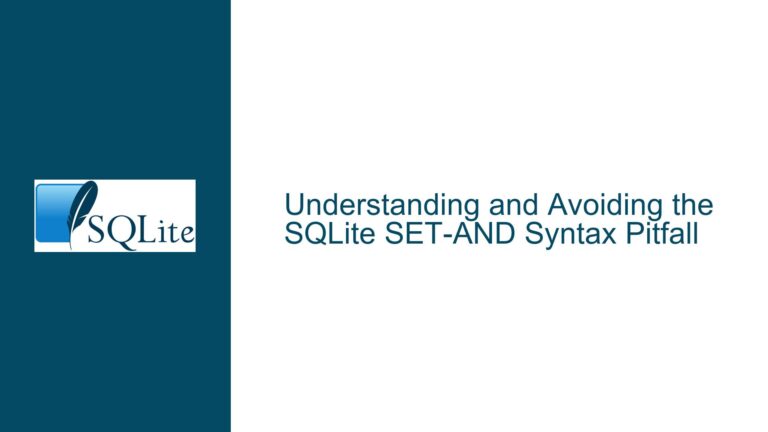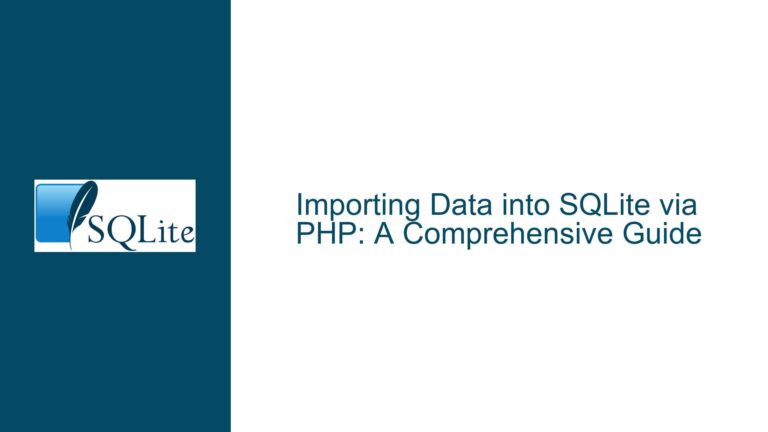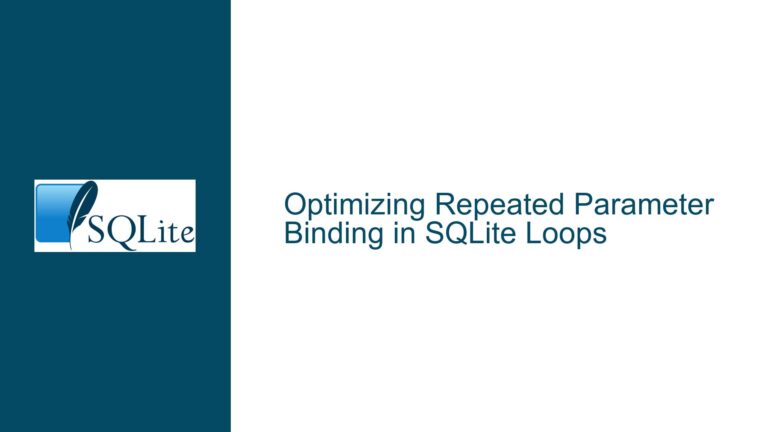Optimizing SQLite UPDATE Queries with Subqueries, CTEs, and UPSERT
Updating SQLite Table Rows Based on Correlated Data
When working with SQLite, a common task is updating rows in a table based on values from other rows within the same table or from a different table. This operation often involves correlating data between rows, such as updating rows of type ‘B’ with values from rows of type ‘A’ where the name column matches. The challenge lies in performing this operation efficiently, especially when dealing with large datasets. SQLite provides several mechanisms to achieve this, including subqueries, Common Table Expressions (CTEs), and the UPSERT feature. Each method has its own strengths and trade-offs, which we will explore in detail.
The core issue revolves around optimizing the update process to avoid iterative row-by-row updates, which can be inefficient and slow. Instead, we aim to leverage SQLite’s capabilities to perform bulk updates in a single statement. This not only improves performance but also ensures atomicity and consistency in the database.
Inefficient Row-by-Row Updates and Lack of JOIN Support in UPDATE Queries
One of the primary causes of inefficiency in SQLite update operations is the use of row-by-row updates, where each row is updated individually within a loop. This approach is often implemented using a SELECT query to fetch the required data, followed by an UPDATE query for each row. While this method works, it is highly inefficient for large datasets due to the overhead of executing multiple queries and the lack of batch processing.
Another limitation is SQLite’s lack of support for JOIN clauses in UPDATE queries. In many other SQL databases, you can directly join tables within an UPDATE statement to correlate data and perform updates in a single query. However, SQLite does not support this syntax, which forces developers to find alternative methods to achieve the same result. This limitation can lead to suboptimal query designs and performance bottlenecks.
Additionally, the absence of proper indexing or unique constraints on the columns used for correlation (e.g., type and name) can exacerbate performance issues. Without these constraints, SQLite may need to perform full table scans to locate the relevant rows, further slowing down the update process.
Leveraging Subqueries, CTEs, and UPSERT for Efficient Updates
To address the inefficiencies and limitations discussed above, we can use several advanced SQLite features: subqueries, Common Table Expressions (CTEs), and the UPSERT feature. Each of these methods provides a way to perform bulk updates in a single statement, avoiding the need for row-by-row processing.
Using Subqueries in UPDATE Statements
Subqueries allow you to embed a SELECT statement within an UPDATE query, enabling you to fetch and use correlated data directly in the update operation. Here’s an example of how to use a subquery to update rows of type ‘B’ with values from rows of type ‘A’:
UPDATE tbl
SET value = (SELECT value
FROM (SELECT type,
name,
value
FROM tbl
WHERE type = 'A')
WHERE name = tbl.name)
WHERE type = 'B'
AND name IN (SELECT name
FROM tbl
WHERE type = 'A');
In this query, the subquery (SELECT value FROM ... WHERE name = tbl.name) fetches the value from rows of type ‘A’ where the name matches the current row being updated. The outer UPDATE statement then applies this value to rows of type ‘B’. The WHERE clause ensures that only rows with matching name values are updated.
This approach eliminates the need for multiple queries and allows SQLite to optimize the update process internally. However, it is essential to ensure that the name column is indexed to avoid full table scans during the subquery execution.
Using Common Table Expressions (CTEs)
Common Table Expressions (CTEs) provide a way to define temporary result sets that can be referenced within a query. CTEs are particularly useful for breaking down complex queries into more manageable parts. Here’s how you can use a CTE to perform the same update operation:
WITH A AS (
SELECT type,
name,
value
FROM tbl
WHERE type = 'A'
)
UPDATE tbl
SET value = (SELECT value
FROM A
WHERE name = tbl.name)
WHERE type = 'B'
AND name IN (SELECT name FROM A);
In this example, the CTE A is defined to select all rows of type ‘A’. The UPDATE statement then uses this CTE to fetch the value for rows of type ‘B’ where the name matches. The WHERE clause ensures that only relevant rows are updated.
CTEs offer better readability and maintainability compared to nested subqueries, especially for complex queries. They also allow SQLite to optimize the query execution plan more effectively.
Using the UPSERT Feature
The UPSERT feature, introduced in SQLite 3.24.0, combines INSERT and UPDATE operations into a single statement. This feature is particularly useful when you want to insert a new row or update an existing row if a conflict occurs (e.g., due to a unique constraint). Here’s how you can use UPSERT to update rows of type ‘B’ with values from rows of type ‘A’:
INSERT
INTO tbl(
type,
name,
value
)
SELECT 'B',
name,
value
FROM tbl
WHERE type = 'A'
ON CONFLICT(type, name) DO
UPDATE
SET value = excluded.value;
In this query, the INSERT statement attempts to insert new rows of type ‘B’ with values from rows of type ‘A’. If a conflict occurs (i.e., a row with the same type and name already exists), the ON CONFLICT clause triggers an UPDATE operation, setting the value to the one from the excluded row (i.e., the row that caused the conflict).
The UPSERT feature is highly efficient and ensures that the operation is atomic. However, it requires a unique constraint on the columns used for conflict detection (e.g., type and name). Without this constraint, the ON CONFLICT clause cannot be used.
Performance Considerations and Best Practices
When choosing between subqueries, CTEs, and UPSERT, consider the following factors:
- Indexing: Ensure that the columns used for correlation (e.g.,
name) are indexed. This is crucial for optimizing the performance of subqueries and CTEs. - Unique Constraints: If you plan to use the UPSERT feature, define unique constraints on the relevant columns (e.g.,
typeandname). - Query Complexity: For simple updates, subqueries may suffice. For more complex queries, CTEs offer better readability and maintainability.
- Atomicity: If atomicity is critical, prefer UPSERT, as it ensures that the operation is performed in a single transaction.
By leveraging these techniques, you can significantly improve the efficiency of your SQLite update operations, ensuring that your database performs optimally even with large datasets.






